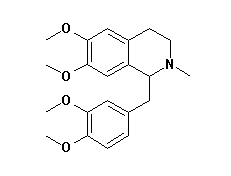Laudanosine
Laudanosine is a metabolite of the neuromuscular-blocking drugs atracurium and cisatracurium with potentially toxic systemic effects.It crosses the blood-brain barrier and may cause excitement and seizure activity. Laudanosine can increases the minimum alveolar concentration of halothane in rabbits.
Inquire / Order:
manager@chemfaces.com
Technical Inquiries:
service@chemfaces.com
Tel:
+86-27-84237783
Fax:
+86-27-84254680
Address:
1 Building, No. 83, CheCheng Rd., Wuhan Economic and Technological Development Zone, Wuhan, Hubei 430056, PRC
Providing storage is as stated on the product vial and the vial is kept tightly sealed, the product can be stored for up to
24 months(2-8C).
Wherever possible, you should prepare and use solutions on the same day. However, if you need to make up stock solutions in advance, we recommend that you store the solution as aliquots in tightly sealed vials at -20C. Generally, these will be useable for up to two weeks. Before use, and prior to opening the vial we recommend that you allow your product to equilibrate to room temperature for at least 1 hour.
Need more advice on solubility, usage and handling? Please email to: service@chemfaces.com
The packaging of the product may have turned upside down during transportation, resulting in the natural compounds adhering to the neck or cap of the vial. take the vial out of its packaging and gently shake to let the compounds fall to the bottom of the vial. for liquid products, centrifuge at 200-500 RPM to gather the liquid at the bottom of the vial. try to avoid loss or contamination during handling.
Biochem Biophys Res Commun.2018, 505(1):194-200
Compounds.2023, 3(1), 169-179.
J.Korean Society of Grassland&Forage Science2023, 43(3):138-147.
J.Food Pharm.Sci.2024, 12(2), 116-124.
Pharmacogn Mag.2015, 11:S585-91
Biomed Pharmacother.2024, 179:117410.
Biol Pharm Bull.2018, 41(11):1685-1693
Oncotarget.2017, 8(53):90925-90947
J Sep Sci.2020, 43(22):4148-4161.
J of the Korean Society of Cosmetics and Cosmetology2018, 399-406
Related and Featured Products
European Journal of Anaesthesiology, 01 Jul 2002, 19(7):466-473.
Laudanosine, an atracurium and cisatracurium metabolite.[Reference:
WebLink]
Laudanosine is a metabolite of the neuromuscular-blocking drugs atracurium and cisatracurium with potentially toxic systemic effects.
It crosses the blood-brain barrier and may cause excitement and seizure activity. Its interest in recent years has increased because of the recognized interaction with gamma-aminobutyric acid, opioid and nicotinic acetylcholine receptors.
METHODS AND RESULTS:
It has been shown to produce analgesia in animals. In the cardiovascular system, high plasma concentrations produce hypotension and bradycardia. In hepatic failure, its elimination half-life is prolonged but only moderate accumulation occurs in adults, whereas in infants and children plasma concentration are greater. In patients undergoing liver transplantation, Laudanosine concentrations are increased during preanhepatic, anhepatic and postanhepatic stages. Patients with renal failure have higher plasma concentrations and a longer mean elimination half-life. In pregnancy, Laudanosine crosses the placental barrier. The mean transplacental transfer is 14% of maternal blood concentrations. Except for prolonged administration of atracurium in intensive care units, Laudanosine accumulation and related toxicity seem unlikely to be achieved in clinical practice.
CONCLUSIONS:
When cisatracurium is used, plasma concentrations of Laudanosine are lower. Further studies are needed, especially around the interactions with gamma-aminobutyric acid, opioid and nicotinic acetylcholine receptors.
Anesthesiology, 1985, 63(6):584-588.
Laudanosine (A Metabolite of Atracurium) Increases the Minimum Alveolar Concentration of Halothane in Rabbits.[Reference:
WebLink]
The authors hypothesized that Laudanosine, a metabolite of atracurium and a central nervous system stimulant, might increase the minimum alveolar concentration (MAC) of halothane.
METHODS AND RESULTS:
An initial study in five rabbits anesthetized with halothane used a two-compartment model to produce estimates of pharmacokinetic variables for Laudanosine. These estimates were used to determine the rates of infusion that would produce steady state plasma concentrations of Laudanosine of approximately 200, 400, and 800 ng . ml-1. Subsequent infusion of Laudanosine in eight rabbits produced mean (+/- SD) steady state plasma concentrations of Laudanosine of 234 +/- 56, 457 +/- 66, and 873 +/- 105 ng . ml-1. The control value for MAC of halothane was 1.08 +/- 0.28%. At the lowest steady state plasma Laudanosine concentration, MAC did not significantly differ from control (MAC = 1.15 +/- 0.23%, P less than 0.1). However, at 457 and 873 ng . ml-1, Laudanosine significantly increased the MAC of halothane by 23% and 30%, respectively. Infusion with saline in two additional rabbits did not affect MAC.
CONCLUSIONS:
Therefore, at the plasma concentrations of Laudanosine found in humans after administration of atracurium, Laudanosine increased the MAC of halothane in rabbits.
BJA: British Journal of Anaesthesia,1986,58(1):14S–18S.
Cardiovascular and Electroencephalographic Effects of Laudanosine in “Nephrectomized” Cats.[Reference:
WebLink]
We studied a cat model simulating Laudanosine accumulation in the “anephric” patient.
METHODS AND RESULTS:
Cardiovascular effects were seen only with the bolus doses of Laudanosine 2 mg kg −1 , and at plasma Laudanosine concentrations unlikely to be achieved clinically. Similarly, EEG and power spectra analysis showed no evidence of epileptiform activity at all plasma Laudanosine concentrations achieved. The non-specific EEG/power spectra changes observed may reflect a direct CNS activity with neurodepression, since Laudanosine was shown by its presence in CSF to cross the blood-brain barrier. These EEG changes were observed at plasma concentrations eight to 10 times those observed in humans during infusion of atracurium.
CONCLUSIONS:
Thus, Laudanosine accumulation and related CNS or cardiovascular toxicity seem unlikely following atracurium administration in the anephric patient.



